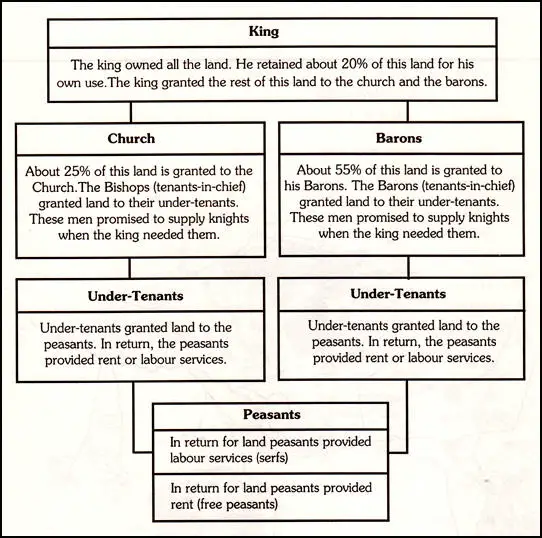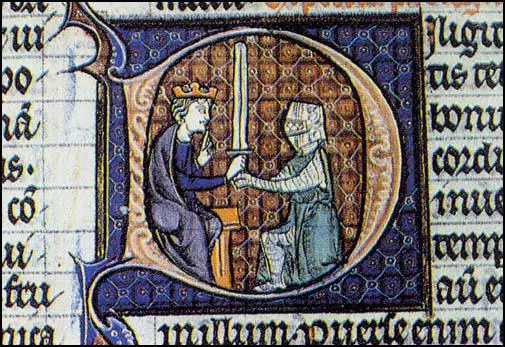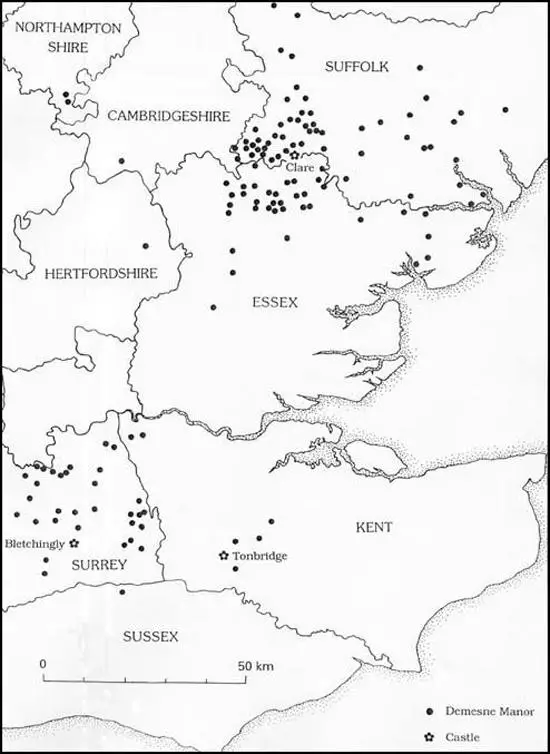The Norman Feudal System
After his coronation, William the Conqueror claimed that all the land in England now belonged to him. William retained about a fifth of this land for his own use. Another 25% went to the Church. The rest were given to 170 tenants-in-chief (or barons), who had helped him defeat Harold at the Battle of Hastings. These barons had to provide armed men on horseback for military service. The number of knights a baron had to provide depended on the amount of land he had been given.
When William granted land to a baron an important ceremony took place. The baron knelt before the king and said: "I become your man." He then placed his hand on the Bible and promised to remain faithful for the rest of his life. The baron would then carry out similar ceremonies with his knights. By the time William and his barons had finished distributing land there were about 6,000 manors in England. Manors varied in size, some having only one village, while others had several villages within its territory. (1)

Richard FitzGilbert is an example of someone who did very well out of the Norman invasion. Richard had the same mother as William the Conqueror, Herleva of Falaise. His father, Gilbert, Count of Brionne, one of the most powerful landowners in Normandy. As Herleva was not married to Gilbert, the boy became known as Richard FitzGilbert. The term 'Fitz' was used to show that Richard was the illegitimate son of Gilbert. (2)
When Robert, Duke of Normandy, William's father died in 1035, William the Conqueror, inherited his father's title. Several leading Normans, including Gilbert of Brionne, Osbern the Seneschal and Alan of Brittany, became William's guardians. A number of Norman barons would not accept an illegitimate son as their leader and in 1040 an attempt was made to kill William. The plot failed but they did manage to kill Gilbert of Brionne. As Richard was illegitimate, he did not receive very much land when his father died. (3)

When William the Conqueror, decided to invade England in 1066, he invited his three half-brothers, Richard FitzGilbert, Odo of Bayeux and Robert of Mortain to join him. Richard, who had married Rohese, daughter of Walter Gifford of Normandy, also brought with him members of his wife's family.
Richard FitzGilbert, was granted land in Kent, Essex, Surrey, Suffolk and Norfolk. In exchange for this land. Richard had to promise to provide the king with sixty knights. In order to supply these knights, barons divided their land up into smaller units called manors. These manors were then passed on to men who promised to serve as knights when the king needed them. (4)

Richard FitzGilbert was given the title, the Earl of Clare. The baron often lived in a castle at the centre of his estates. FitzGilbert built castles at Tonbridge (Kent), Clare (Suffolk), Bletchingley (Surrey) and Hanley (Worcester). His knights normally lived in the manor that they had been granted. Once or twice a year, FitzGilbert would visit his knights to check the manor accounts and to collect the profits that the land had made. (5)
Barons often kept about a third of the land in the manor for their own use (the demesne). Another large area was given to the knight who looked after the manor. The rest was divided up between the church (the glebe land) and the peasants who lived in the village. Those peasants who were freeman would rent the land for an agreed fee. However, the vast majority of the peasants were unfree. These unfree peasants, who were called villeins or serfs, had to provide a whole range of services in exchange for the land that they used. The main requirement of the serf was to supply labour service. This involved working on the demesne without pay for several days a week. As well as free labour, serfs also had to provide the oxen plough-team or any equipment that was needed.
Primary Sources
(1) Kettering Abbey provided land for forty villeins. In exchange for holding 30 acres the villeins had to provide several feudal services.
Kettering Abbey provided land for forty villeins. In exchange for holding 30 acres the villeins had to provide several feudal services. Three days a week work on the 88 acres held by the abbey. Every year they had to provide 50 hens, 640 eggs and 2s. Id. in cash.
(2) Pope Gregory VII in a letter to the Bishop of Metz in 1081.
Kings and leaders are sprung from men who were ignorant of God, who by pride, robbery, murder, in a word, by almost every crime in the devil... to dominate over their equals, that is, over mankind.
(3) Bishop Fulbert of Normandy (c. 1150)
He who swears fealty to his lord must not injure his lord by giving up secrets of his castles... he must do nothing to injure the rights of justice of his lord... he must do no wrong to his lord's possessions.
(4) Edward Hasted, The History of the County of Kent (1797)
Richard de Clare came into England with William the Conqueror and gave him great assistance at the Battle of Hastings... in return he was granted large estates in England.
(5) Jennifer Ward, The Lands of the Clare Family (1980)
William the Conqueror aimed to secure Kent and Sussex and to guard the routes to London by giving estates there to men on whom he especially trusted... important places like Tonbndge on the River Medway, was given to Richard de Clare... Richard de Clare granted some of his manors to vassals. Stoke in Surrey, for instance, was given to Roger de Abernon... vassals like Roger de Abernon performed military service
(6) Letter sent by William of Siward to King Henry II in 1166
I am letting you know by this letter that I hold from you a certain village, Gosford by name, and the half of another which is called Milton, for the fee and service of one knight, which I faithfully perform for you, as my ancestors have done to your ancestors.
(7) Walter of Guisborough, Chronicle (c. 1310)
Earl Warenne was called before the king's judges. The judges asked to see his warrant (documents that proved that he owned his land)... he produced an ancient and rusty sword and said: "Look at this, my lords, this is my warrant! For my ancestors came with William and conquered their lands with the sword, and by the sword I will defend them from anyone intending to seize them. The king did not conquer and subject the land by himself, but our forebears were sharers and partners with him."
(8) Jean Froissart, Chronicles (c. 1395)
It is the custom in England, as in other countries, for the nobility to have great power over the common people, who are their serfs. This means that they are bound by law and custom to plough the fields of their masters, harvest the corn, gather it into barns, and thresh and winnow the grain; they must also mow and carry home the hay, cut and collect wood, and perform all manner of tasks of this kind.
(9) Domesday entry for Standon in Hertfordshire (1086)
Rohese, wife of Richard, son of Count Gilbert, holds Standon. Land for 24 ploughs. 29 villagers with a priest. 15 smallholders, 2 freemen and a Frenchman have 12 ploughs. 9 cottagers and 8 slaves. 5 mills at 45s; meadow for 24 ploughs; pasture for livestock; woodland, 600 pigs. Total value in 1086 £33; before 1066 £34. Archbishop Stigand held this manor in 1066. In this manor were six freemen.
Student Activities
The Battle of Hastings (Answer Commentary)
William the Conqueror (Answer Commentary)
The Feudal System (Answer Commentary)
The Domesday Survey (Answer Commentary)
Thomas Becket and Henry II (Answer Commentary)
Why was Thomas Becket Murdered? (Answer Commentary)
Illuminated Manuscripts in the Middle Ages (Answer Commentary)
